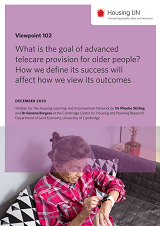What is the goal of advanced Telecare provision for older people? How we define its success will affect how we view its outcomes

This Viewpoint (no 102) by the University of Cambridge's Centre for Housing and Planning Research draws on their recent research, funded by the Dunhill Medical Trust, and suggests that there is a discrepancy in opinion about what telecare is for and the goals to be achieved, between telecare designers, suppliers, manufacturers, local authority commissioners, housing association managers, and the many others professionally engaged in rolling out telecare services.
How these goals are held in tension and how they impact the definition of successful provision are discussed in this piece for the Housing LIN.
The viewpoint highlights that here are many different goals at play in advanced telecare provision. For example, it cites that for adult social care, telecare is successful if it reduces the need for health, domiciliary and residential care, a primary benefit of which is reduced demand on adult social care budgets.
It also points out that some telecare providers are more motivated by the 'analogue switch off' in 2025, which will see the permanent removal of analogue phone lines by BT. As a consequence, all communications technologies will need to be fully digitised by this date, meaning that the telecare technology, used by many housing associations and others providing housing and care for older people, will need to be replaced. For providers, replacing their telecare systems for more advanced, digital interfaces is imperative and their decisions around telecare provision have a hard time deadline.
